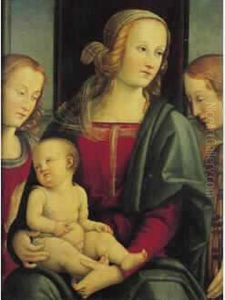Master Of Ponterosso Paintings
The Master of Ponterosso is an anonymous painter from the Italian Trecento, the period corresponding to the 14th century. Not much is known about the life of this artist, as was common with many medieval craftsmen whose personal details were not always documented or preserved. The name 'Master of Ponterosso' is a notname (a name assigned by art historians) derived from a landmark or location associated with a significant work or group of works by the artist. This practice allows scholars to discuss and categorize the body of work of artists whose true names have been lost to time.
The artist's works are typically characterized by the stylistic elements prevalent during the period, which include Byzantine influences and the emergence of more naturalistic approaches to figure and space representation, as seen in the works of Giotto and other proto-Renaissance artists. The Master of Ponterosso would have been part of this movement towards greater realism, but still firmly rooted in the medieval tradition.
Attributions of works to the Master of Ponterosso are based on stylistic analysis, since no documented works signed by the artist are known. This means that the body of work associated with this master is subject to change as scholarship advances and understandings of regional stylistic variations evolve. Art historians might attribute panel paintings, frescoes, and possibly illuminated manuscripts to the Master of Ponterosso, looking for consistencies in technique, iconography, and stylistic quirks.
Since the details of the Master of Ponterosso's life are unknown, there is no specific death date available for the artist. The active period of the artist is usually the only temporal anchor art historians have, which for the Master of Ponterosso, would be sometime in the 14th century. The legacy of the Master of Ponterosso, like many medieval artists, is preserved in the physical works attributed to them and the influence those works had on the development of Italian painting. Despite the anonymity, the Master of Ponterosso contributes to the rich tapestry of art history and provides insight into the cultural and artistic practices of the time.
